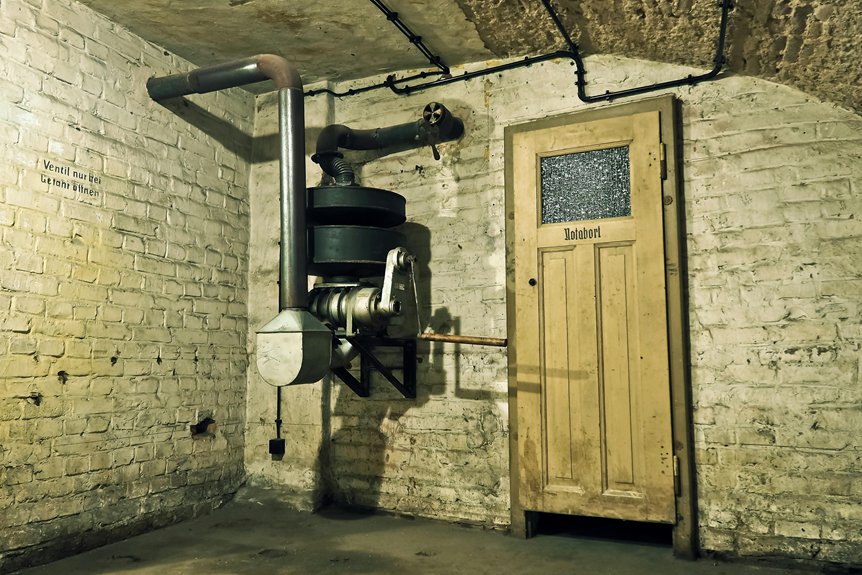If you’re a homeowner in Ann Arbor, understanding basement waterproofing methods is essential for protecting your property. With various techniques available, you can effectively prevent water damage and maintain a dry environment. From interior drainage systems to effective grading strategies, each method offers unique benefits. As you explore these options, consider how they can fit into your home’s maintenance plan and guarantee your basement remains a safe, functional space.
Key Takeaways
- Interior Drainage Systems efficiently channel water away from basements using drainage tiles and sump pumps to prevent damage and maintain a dry environment.
- Exterior Waterproofing applies barriers to foundation walls and includes drainage systems to manage surface water, protecting structural integrity.
- Sump Pump Installation is crucial for removing excess water and preventing damage, with regular maintenance ensuring optimal performance.
- Vapor Barriers reduce humidity and mold growth by sealing moisture-prone areas, promoting a healthier indoor environment.
- Grading and Landscaping techniques, such as sloping and French drains, effectively direct rainwater away from foundations, preventing water pooling.
Interior Drainage Systems
When water seeps into your basement, you need an effective solution, and interior drainage systems can be just that.
These systems utilize drainage tiles installed around the perimeter of your basement to efficiently channel water. As water collects, the tiles direct it to a sump pump, which then removes the excess moisture, preventing damage to your home.
This proactive approach not only protects your basement but also enhances your living space. By addressing water collection early, you can avoid costly repairs and maintain a dry, healthy environment.
Invest in an interior drainage system for long-term peace of mind.
Exterior Waterproofing
Exterior waterproofing is an essential step in protecting your Ann Arbor home from water intrusion. This process involves applying a waterproof barrier to your foundation walls and installing effective drainage systems to manage surface water.
Proper landscape design can also help direct rainwater away from your home, reducing the risk of flooding. Consider grading your yard, using gutters, and creating drainage swales to enhance water flow.
Regular maintenance of these systems is important to guarantee they function effectively. By investing in exterior waterproofing methods, you’ll safeguard your home’s structural integrity and keep your basement dry for years to come.
Sump Pump Installation
A sump pump is an essential addition for keeping your Ann Arbor basement dry and preventing water damage.
There are various sump pump types, including submersible and pedestal pumps, each suited for different needs.
When installing, make sure it’s placed in the lowest part of your basement and connected to a proper drainage system.
Regular sump pump maintenance is critical; check the pump and discharge line for clogs and test it monthly to verify it’s functioning.
Vapor Barriers
After ensuring your sump pump is in place, think about adding vapor barriers to your basement for extra protection against moisture.
Vapor barriers help prevent dampness and mold growth, ensuring a healthier environment. Here are some key points to reflect on:
Vapor barriers are essential for preventing dampness and mold, promoting a healthier basement environment.
- Vapor barrier materials: Choose polyethylene, foil-faced, or rubberized options for effective moisture control.
- Installation location: Install barriers on walls or floors where moisture is prevalent.
- Sealing: Properly seal seams and edges to maximize effectiveness.
- Maintenance: Regularly inspect for damage or wear to maintain ideal performance.
Implementing vapor barrier installation can greatly improve your basement’s durability and comfort.
Grading and Landscaping
To effectively manage water around your home, proper grading and landscaping are essential. This guarantees effective drainage solutions and prevents water from pooling near your foundation. You should also consider your soil composition; different types of soil absorb and drain water differently.
| Grading Technique | Benefits | Recommended Soil Type |
|---|---|---|
| Sloping | Redirects water away | Sandy loam |
| Swales | Collects and channels | Clay |
| Retaining walls | Prevents erosion | Well-drained soil |
| French drains | Reduces flooding | Loamy soil |
| Rain gardens | Enhances absorption | Native plants |
Implementing these strategies will greatly enhance water management.
Foundation Crack Repair
When it comes to foundation cracks, understanding their types is essential for effective repair.
You’ll want to explore various repair techniques and proactive measures to prevent future issues.
Addressing these cracks promptly can save you time and money in the long run.
Types of Foundation Cracks
While foundation cracks can be concerning, understanding the different types can help you address them effectively.
You’ll typically encounter two main types of cracks in your foundation:
- Horizontal cracks: Often indicate significant pressure from surrounding soil.
- Vertical cracks: Usually result from normal settling and are generally less serious.
- Diagonal cracks: May suggest foundation movement and should be monitored.
- Hairline cracks: Often cosmetic, but keep an eye on them for any changes.
Recognizing these types can guide you in determining the necessary actions to take for your home’s foundation health.
Repair Techniques Overview
Understanding the repair techniques for foundation cracks is essential, especially if you want to maintain your home’s structural integrity. One effective method is epoxy injection, which fills cracks and restores strength.
Additionally, polyurethane foam can seal cracks while expanding to fill voids, providing moisture control. For larger issues, consider installing a carbon fiber strip to reinforce the foundation.
Don’t forget about basement insulation; it plays a significant role in preventing moisture from seeping through cracks. By addressing these repairs promptly, you’ll enhance your home’s durability and protect it from further damage caused by water infiltration.
Preventative Measures Suggested
To prevent foundation cracks from developing in the first place, it’s essential to take proactive measures around your home.
Effective rainwater management is vital for maintaining your foundation’s integrity. Regular home maintenance can save you from costly repairs later.
Here are some key steps you can take:
- Confirm proper grading away from your home.
- Clean gutters and downspouts to prevent overflow.
- Install a sump pump if necessary.
- Monitor soil moisture levels to avoid excessive expansion or contraction.
Dehumidifiers and Ventilation Systems
When moisture levels rise in your Ann Arbor basement, installing dehumidifiers and effective ventilation systems can make a significant difference. These systems help maintain humidity control, ensuring your space remains dry and comfortable. Dehumidifiers extract excess moisture, while ventilation systems improve air circulation, preventing dampness and mold growth.
| System Type | Benefits | Ideal Use Case |
|---|---|---|
| Dehumidifier | Reduces humidity, prevents mold | Spaces with high moisture |
| Ventilation System | Enhances air circulation | Areas prone to stagnation |
| Combination | Best humidity control | Large or damp basements |
| Energy Recovery | Energy-efficient air exchange | Homes needing efficiency |
| Smart Systems | Automated humidity control | Tech-savvy homeowners |
Conclusion
By implementing these seven common basement waterproofing methods, you can effectively protect your Ann Arbor home from water damage. Whether you opt for interior drainage systems, exterior waterproofing, or proper grading, each technique plays a crucial role in maintaining a dry and healthy basement. Don’t forget regular maintenance and repairs to guarantee your systems work efficiently. With the right approach, you can keep your basement safe and your home in excellent condition for years to come.




